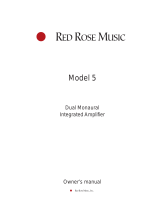
Operation
Continuous operation is not recommended. If the amplifiers will not be auditioned for a few hours it is best to
turn them off. This avoids undue stress to the KT88 output tubes.
As with all high fidelity products, the sound characteristics of the VAC amplifiers change somewhat as they
warm up. Best sound will be achieved after 15 minutes of operation, with subtle changes occurring for up to
one hour. However, we advise against leaving the equipment on at all times because of the attendant
acceleration of output tube wear. Life of the output tubes averages between 2,000 and 8,000 hours depending
upon brand fitted and random variations within the tubes themselves.
Any time that the VAC Power Amplifier has not been used for a few weeks the sound may be different. This is
also normal for high resolution audio equipment. Optimum sound should return after a few hours of operation,
preferably with an audio signal.
Please note that although your VAC amplifiers have been run for 48 hours at the factory, they will continue to
"break in" for approximately 150 hours. Also be aware that many components display the need for a new break
in period after being transported in unheated cargo aircraft.
Bias Adjustment
Your VAC Power Amplifier has been shipped with output tube bias preset. This should be checked when you
install your amplifier, and periodically thereafter. It must also be set whenever an output tube is changed.
Adjustment of the output tubes is quite easy, and requires only a small screwdriver. On the front panel are four
bi-color LEDs, each with an adjacent adjustment control. View the LEDs from directly in front, not from above
or below. Adjust the LEDs to be green when the amplifier is not playing music. To set, turn the control
clockwise until the LED just begins to change to an amber/red color, and then back the control off just slightly
to restore the pure green color.
As music plays, the LEDs will vary from green to red. Check the bias if you ever see an LED stay red while
music is not playing, or if an LED does not tend toward amber or red when music is playing. If the flashing of
the LEDs is bothersome while listening, the switch on the front labelled “Bias Test” can be set to “0", disabling
the LEDs. The switch must then be set to “1" to check the bias of the output tubes.
Any tube that can not be adjusted to the correct bias point should be replaced. Any tube which requires constant
readjustment should be replaced immediately. Never operate the amplifier with an LED that shows red when
music is not playing.
When installing new tubes, set the bias controls counter-clockwise. Check the bias of both channels as the
amplifier warms up - don't wait ten minutes.
Bias levels should be checked monthly to ensure optimum sound quality. It is not unusual for the bias to change
with time, particularly when tubes are new. The greatest amount of drift occurs during the first 200 hours of
a tube's life. The drift may change direction periodically, such that the bias control must be increased and later
decreased, or vice versa. Check bias if the sound seems lacking in detail or dynamics.
Tube Types
The input/splitter tube and the driver tube may be type 12AU7A/ECC82/E82CC or type 12BH7 (typically richer
sound). The output tubes are type KT88. Please feel free to contact VAC if you require additional information
or advice.











